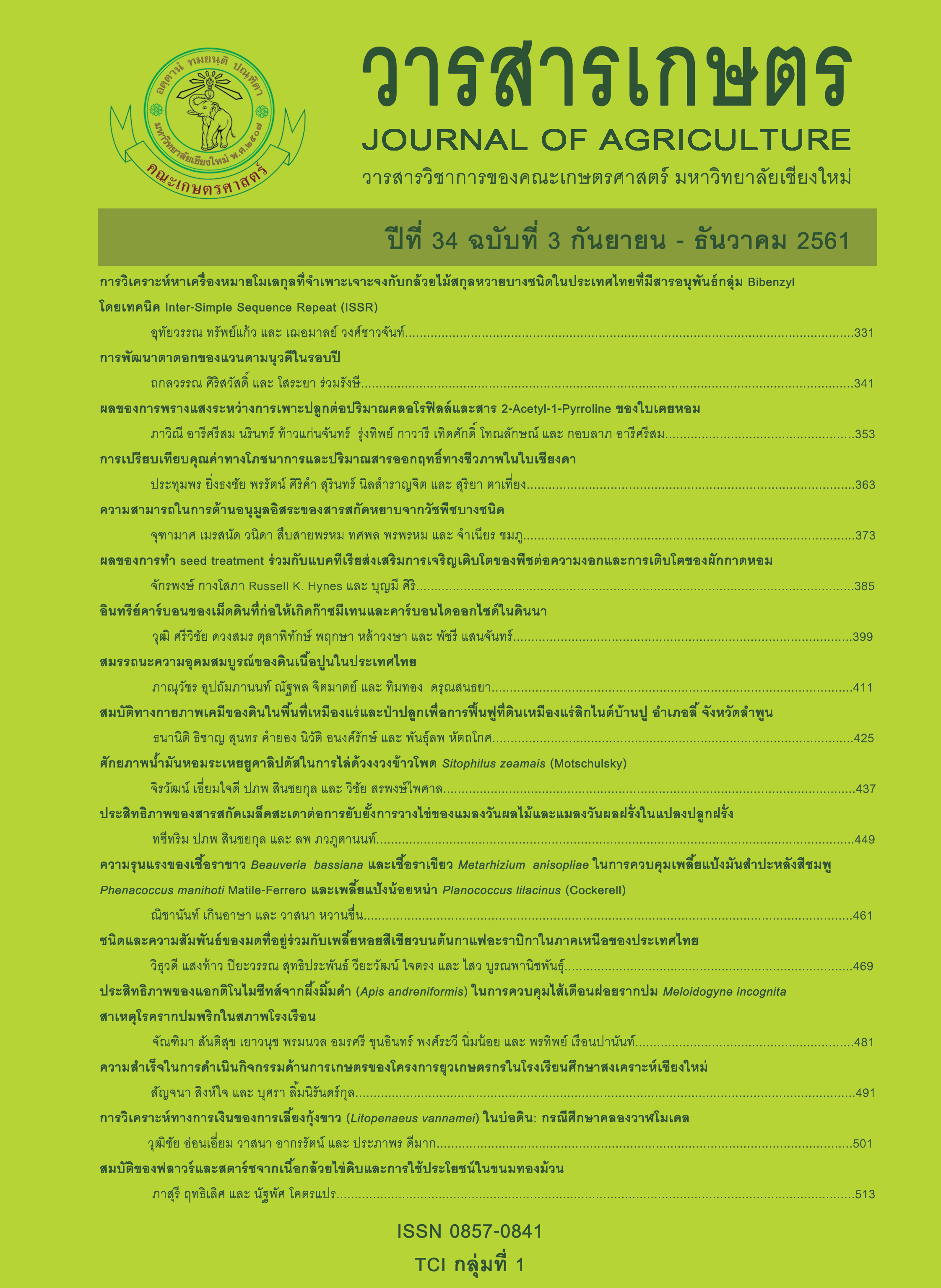ชนิดและความสัมพันธ์ของมดที่อยู่ร่วมกับเพลี้ยหอยสีเขียวบนต้นกาแฟอะราบิกาในภาคเหนือของประเทศไทย
Main Article Content
บทคัดย่อ
การศึกษาชนิดและความสัมพันธ์ของมดกับเพลี้ยหอยสีเขียว Coccus viridis บนต้นกาแฟอะราบิกาในพื้นที่ภาคเหนือ ที่ความสูงจากระดับน้ำทะเลแตกต่างกัน 3 ระดับ ได้แก่ 1) ที่ระดับความสูงประมาณ 930 เมตร บ้านป่าเมี่ยง อำเภอดอยสะเก็ด จังหวัดเชียงใหม่ 2) ที่ความสูง 1,200 เมตร บ้านขุนลาว อำเภอเวียงป่าเป้า จังหวัดเชียงราย และ 3) ที่ระดับความสูง 1,350 เมตร บริเวณสถานีวิจัยเกษตรที่สูงขุนช่างเคี่ยนไร่หน้า (ขุนช่างเคี่ยน) อำเภอเมือง จังหวัดเชียงใหม่ ได้สำรวจพบมดที่อยู่บนทรงพุ่มของต้นกาแฟทั้งหมด 78 ชนิด 27 สกุล จาก 6 วงศ์ย่อย ในจำนวนนี้ พบที่บ้านป่าเมี่ยง 51 ชนิด 22 สกุล 6 วงศ์ย่อย พื้นที่บ้านขุนลาว 45 ชนิด 19 สกุล 5 วงศ์ย่อย และพื้นที่ขุนช่างเคี่ยน 33 ชนิด 18 สกุล 5 วงศ์ย่อย และพบว่ามดและเพลี้ยหอยสีเขียวระบาดมากในช่วงฤดูฝน และมีแนวโน้มลดจำนวนลงในช่วงฤดูแล้ง พื้นที่บ้านป่าเมี่ยงพบการระบาดของเพลี้ยหอยสีเขียวมากที่สุด ในขณะที่พื้นที่ขุนช่างเคี่ยนมีการระบาดน้อยที่สุด จำนวนมดกับจำนวนเพลี้ยหอยสีเขียวมีแนวโน้มความสัมพันธ์กันในเชิงบวก การศึกษานี้พบมดที่อยู่ร่วมต้นกาแฟเดียวกับเพลี้ยหอยสีเขียว ทั้งหมด 48 ชนิด และในจำนวนนี้มีมด 12 ชนิดที่มีปฏิสัมพันธ์ร่วมกับเพลี้ยหอยสีเขียว ได้แก่ Dolichoderus butteli, Dolichoderus feae, Dolichoderus taprobanae, Dolichoderus thoracicus, Tapinoma melanocephalum, Technomyrmex albipes, Technomyrmex modiglianii, Technomyrmex yamanei, Anoplolepis gracilipes, Oecophylla smaragdina, Crematogaster rogenhoferi และ Pheidole dugasi.
Article Details
เอกสารอ้างอิง
ชมัยพร บัวมาศ และ เดชา วิวัฒน์วิทยา. 2548. การศึกษามดในห้วยเขย่ง อำเภอทองผาภูมิ จังหวัดกาญจนบุรี. วารสารวนศาสตร์ 24: 59-72.
ชุลีรัตน์ รังสรรค์ ปิยะวรรณ สุทธิประพันธ์ และ เยาวลักษณ์ จันทร์บาง. 2559. ชีววิทยาของเพลี้ยหอยสีเขียว (Coccus viridis Green) และการควบคุมด้วยสารฆ่าแมลงและเชื้อราสาเหตุโรคแมลงในแปลงปลูกกาแฟ. วารสารเกษตร 32(1): 83-93.
เดชา วิวัฒน์วิทยา. 2550. มดห้ำ. ข่าวสารเกษตรศาสตร์ 52(2): 14-22.
ปิยะวรรณ สุทธิประพันธ์ และ เยาวลักษณ์ จันทร์บาง. 2557. การสำรวจแมลงศัตรูกาแฟอาราบิก้าและแมลงศัตรูธรรมชาติ ในจังหวัดเชียงใหม่และเชียงราย. วารสารเกษตร 30(3): 233-242.
เผ่าไท ถายะพิงค์ และ ปิยะวรรณ สุทธิประพันธ์. 2558. การประยุกต์ใช้เทคโนโลยีภูมิสารสนเทศในการศึกษาความหลากชนิดและการแพร่กระจายของแมลงศัตรูกาแฟอาราบิกาในจังหวัดเชียงใหม่และเชียงราย. วารสารเกษตร 31(2): 203-213.
วียะวัฒน์ ใจตรง. 2554. คู่มือการจำแนกสกุลมดในประเทศไทย. บริษัทพดด้วง เอ็นเตอร์ไพร์ส, ปทุมธานี. 155 หน้า.
สำนักงานเศรษฐกิจการเกษตร. 2559. กาแฟ. (ระบบออนไลน์). แหล่งข้อมูล: https://www.oae.go.th/download/prcai/farmcrop/coffee.pdf (10 มกราคม 2561).
Araújo L. M. and G. W. Fernandes. 2003. Altitudinal patterns in a tropical ant assemblage and variation in species richness between habitats. Lundiana 4(2):103-109.
Bach, C.E. 1991. Direct and indirect interactions between ants (Pheidole megaceph), scales (Coccus viridis) and plants (Pluchea indica). Oecologia 87: 233-239.
Barrera, J.F. 2008. Coffee pests and their management. pp. 961-998. In: J.L. Capinera (ed.). Encyclopedia of Entomology. Springer, Dordrecht.
Bharti H., Y. Sharma, M. Bharti and M. Pfeiffer. 2013. Ant species richness, endemicity and functional groups, along an elevational gradient in the Himalayas. Asian Myrmecology 5: 79-101.
Bolton, B. 2007. Taxonomy of the dolichoderine ant genus Technomyrmex Mayr (Hymenoptera: Formicidae) based on the worker caste. Contributions of the American Entomological Institute 35(1): 1-149.
Burwell C.J. and A. Nakamura. 2011. Distribution of ant species along an altitudinal transect in continuous rainforest in subtropical Queensland, Australia. Memoirs of the Queensland Museum - Nature 55(2): 391-411.
Gullan, P.J. 1997. Relationships with ants. pp. 351-373. In: Y. Ben-Dov and C.J. Hodgson (eds.). Soft Scale Insects - Their Biology, Natural Enemies and Control. Elsevier Science, Amsterdam.
Itioka, T. and T. Inoue. 1996. The role of predators and attendant ants in the regulation and persistence of a population of the citrus mealybug Pseudococcus citrisculus in a Satsuma orange orchard. Applied Entomology & Zoology 31(2):195-202.
Jahn, G.C., J.W. Beardsley and H.G. Hernandez. 2003. A review of association of ants with mealybug wilt disease of pineapple. Hawaiian Entomological Society 36: 9-28.
Jaitrong, W. and J. Nabhitabhata. 2005. A list of known ant species of Thailand (Formicidae: Hymenoptera). The Thailand Natural History Museum Journal 1(1): 9-54.
Jaitrong, W., P. Kumthong and S. Hasin. 2007. Nest structure and nesting habits of Polyrhachis muelleri Forel, 1893 in eastern Thailand (Hymenoptera: Formicidae). The Thailand Natural History Museum Journal 2(1): 19-25.
Jha, S., J.H. Vandermeer and I. Perfecto. 2009. Population dynamics of Coccus viridis, a ubiquitous ant-tended agricultural pest, assessed by a new photographic method. Bulletin of Insectology 62(2): 183-189.
Johnson C., D. Agosti, J.H. Delabie, K. Dumpert, D. J. Williams, M. von Tschirnhaus and U. Maschwitz. 2001. Acropyga and Azteca ants (Hymenoptera: Formicidae) with scale insects (Sternorrhyncha: Coccoidea): 20 million years of intimate symbiosis. American Museum novitates, no. 3335. American Museum of Natural History, New York. 18 p.
Krebs, C.J. 1999. Ecological Methodology. 2nd ed. Benjamin/Cummings, Menlo Park, CA. 620 p.
Kusnezov, N. 1957. Numbers of species of ants in faunae of different latitudes. Evolution 11: 298-299.
Liefke, C., W.H.O. Dorow, B. Holldobler and U. Maschwitz. 1998. Nesting and food resources of syntopic species of the ant genus Polyrhachis (Hymenoptera, Formicidae) in West-Malaysia. Insectes Sociaux 45: 411-425.
Murphy, S.T. 1991. Insect natural enemies of coffee green scales (Hemiptera: Coccidae) in Kenya and their potential for biological control of Coccus celatus and C. viridis in Papua New Guinea. Entomophaga 36(4): 519-529.
Onishi, Y., P. Suttiprapan, J. Kulsarin, W. Jaitrong and F. Ito. 2017. Behavioral interactions between coffee berry borers and ants in Chiang Mai, Thailand. Journal of Agriculture 33(1): 1-8.
Onishi, Y., W. Jaitrong, P. Suttiprapan, S. Buranapanichpan, Y. Chanbang and F. Ito. 2016. Ant species diversity in coffee plantation in Chiang Mai province, northern Thailand. The Thailand Natural History Museum Journal 10(1): 33-48.
Shattuck, S. O. 2000. Australian Ants: Their Biology and Identification. CSIRO Publishing, Collingwood. 226 p.
Southwood, T.R.E. 1978. Ecological Methods. 2nd ed. Chapman & Hall, New York. 524 p.
Torchote, P., D. Sitthicharoenchai and C. Chaisuekul. 2010. Ant species diversity and community composition in three different habitats: mixed deciduous forest, teak plantation and fruit orchard. Tropical Natural History 10(1): 37-51.
Watanasit, S., S. Tongjerm and D. Wiwatwitaya. 2005. Composition of canopy ants (Hymenoptera: Formicidae) at Ton Nga Chang Wildlife Sanctuary, Songkhla province, Thailand. Songklanakarin Journal of Science and Technology 27 (Suppl. 3): 665-673.
Watt, A.D., N.E. Stork and B. Bolton. 2002. The diversity and abundance of ants in relation to forest disturbance and plantation establishment in southern Cameroon. Journal of Applied Ecology 39: 18-30.
Weiser, M.D., N.J. Sander, D. Agosti, A.N. Andersen, A.M. Ellison, B.L. Fisher, H. Gibb, N.J. Gotelli, A.D. Gove, K. Gross, B. Guénard, M. Janda, M. Kaspari, J.P. Lessard, J.T. Longino, J.D. Majer, S.B. Menke, T.P. McGlynn, C.L. Parr, S.M. Philpott, J. Retana, A.V. Suarez, H.L. Vasconcelos, S.P. Yanoviak and R.R. Dunn. 2010. Canopy and litter ant assemblages share similar climate - species density relationships. Biology Letters 6: 769-772.


